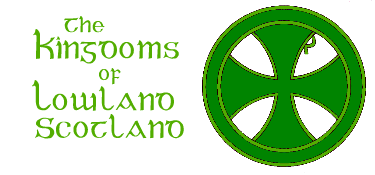
EBK Home
Kingdoms
Royalty
Saints
Pedigrees
Archaeology
King Arthur
Mail David

In the 5th century, after Britain had been forced to leave the Roman Empire, there was, as yet, no England (named after the Anglo-Saxons), no Wales (a Saxon word for place of the foreigners) and no Scotland (named after the Scotti from Ireland). What is now modern Scotland was then divided into three distinct areas:
- Pictland: The northern region where the (probably non-Celtic) picts lived
- Dalriada: The area around Argyle where the (Q-Celtic) Scotii originally settled before they came to dominate the whole region.
- Lowland British Kingdoms: The land between the Roman Walls of Hadrian & Antoninus Pius inhabited by the (P-)Celtic peoples who had been under Roman jurisdiction for only twenty-four years between AD 138 & 162.
The lowland British Kingdoms essentially stemmed from two sources. The Kingdom of Gododdin, centred on Trapain Law in Lothian, emerged under a leading family from the local tribe of the Votadini (after whom the kingdom was named). It was later called Lothian, after its most famous monarch, King Lot of Arthurian tradition.
Most of the region, however, was ruled over by descendants of Ceretic Guletic (the Land-Holder or Imperator), an early 5th century character well-known for his reprimand from St. Patrick. The elder dynasty held the Overlordship of Strathclyde. Whilst younger branches established sub-kingdoms in the tribal home of the Selgovae (around Selkirk) and in Galloway & Ynys Manaw (Strathclyde). There was some confusion in the early genealogies of these kings. Later monarchs appear to have rejected their descent from Ceretic in favour of claiming the more prestigious Magnus Maximus as their ancestor.
Strathclyde was the most durable of British Kingdoms outside Wales & Brittany. It survived well into the late 9th century, when intermarriage with the ruling House of Scots led to a merging of the two realms.
